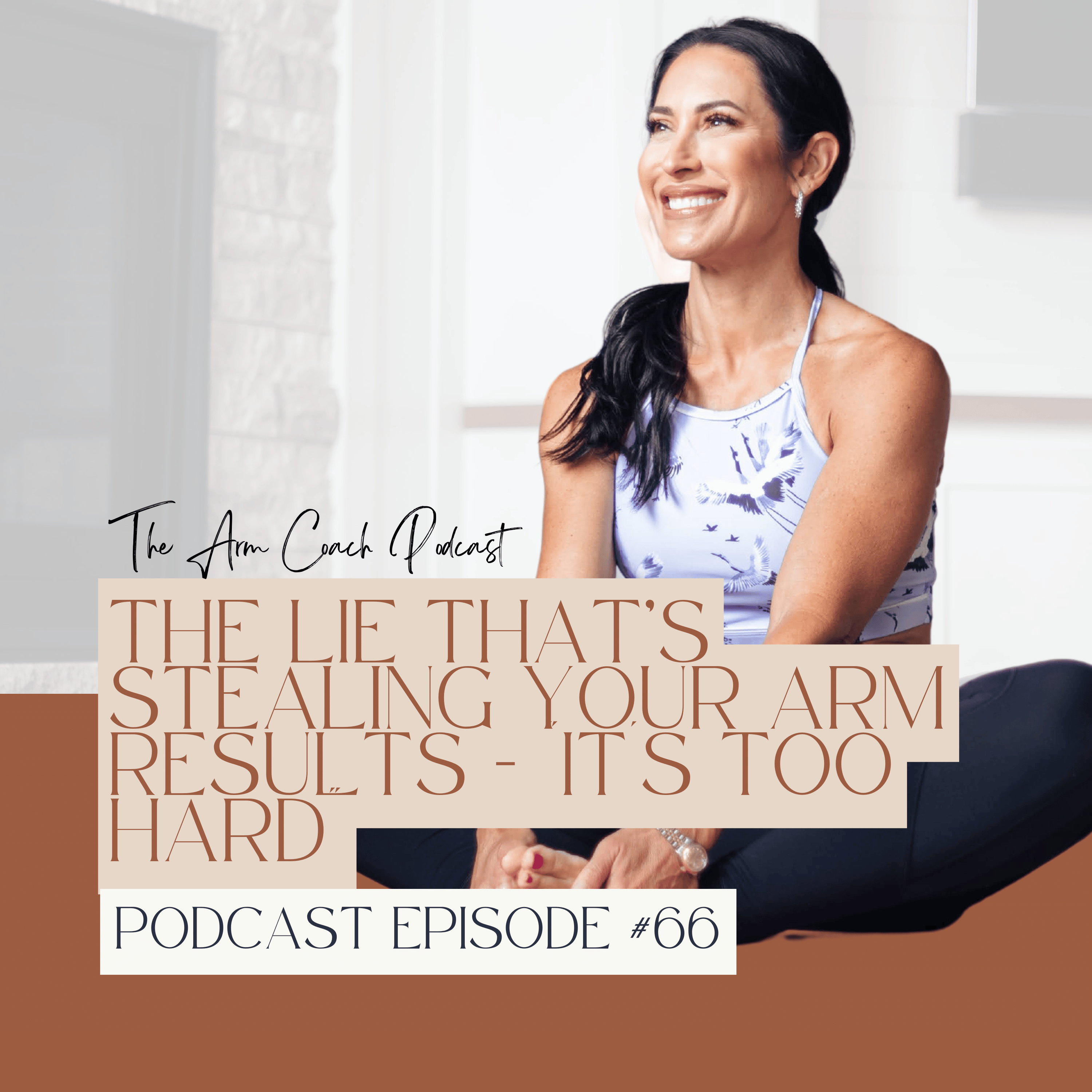Episode Transcript
Hi, everybody, and welcome to The Arm Coach podcast, episode
#3.
Today I’d like to talk with you about a type of weight training
called Progressive Overload Training. I found this type of training
when I became super frustrated with all my workout efforts never
showing up in the mirror.
Now when I was a young adult I weight 200 lbs. Through trial and
error I figured out how to lose my weight and I ended up losing 80
lbs. Now while I was losing weight, I also decided to try weight
lifting. Mostly because I couldn’t go the grocery store and
checkout without seeing beautiful, strong, shapely women on
several different fitness magazines. And listen, I found their
physics so beautiful and I longed to have strong, shapely arms and
legs.
So I eventually got to where I was going to the gym 3-4 days a
week, doing all the workouts I’d find in fitness magazines. I’d rip
them out and I kept a folder of workouts that I’d take to the gym.
Listen, I’m 55 years old. This was before the internet and cell
phones are what they are today. This was old school ok??? So I’d
roll up to the gym and randomly pull out a workout and then get
to work. Now this went on for several years. I feel in love with
weight training, mostly because it was such a great release for me.
I was a single parent for over 12 years, and as you know or can
image, parenting has it’s challenges. And also I was so lonely. But
the gym had childcare and so it was a great way for me to get out
of the house, meet people and do something good for my body.
But after awhile it became frustrating. Because I felt like I was
doing all the things, right? Lost the excess weight, going to the
gym, doing my exercise routines from the magazines, I was even
trying to follow the recipes from the magazines. So why wasn’t my
body looking even remotely like the ladies in the magazines???
I decided it was time to get 1:1 support. I hired a personal trainer.
Now I’ve actually had several trainers in my life but it wasn’t until
I found Lori that my body started to transform. She coached
figure competitors and believed that I had could have a stage
physic if I followed her plan. I was so skeptical, especially when
she told me to do the same workout every week for 12 weeks. I was
like What? How’s that going to work? But I decided to lean on her
belief and follow her plan of progressively overloading my
muscles.
So that’s what I want to explain to you today.
Progressive overload training is the process of gradually
increasing the intensity of your workouts to increase your muscle
size, strength, and endurance. And though progressive overload
can be applied to a variety of different exercises, most progression
models involve increasing the weight and time of resistance
training.
Typically what I see is that people have a variety different goals
when it comes to progressive overload of their arms. Some people
choose to build muscle mass while others focus on improving the
tone of their muscles.
Progressive overload is also a good option to keep your workouts
fresh, simple and challenging and can even help you avoid
reaching a plateau. So let’s dive into what you need to know about
progressive overload including how it works, its benefits.
How Does Progressive Overload Work?
When incorporating progressive overload into a training regimen,
many people follow the "principle of progressive overload." This
principle indicates that in order to allow for gradual adaptation of
your muscles, your increases in weight, intensity, repetitions, or
time should be kept within 10% or less each week. Doing so, also
minimizes your risk of injury.
Progressive overload is effective because the additional stress you
put on your muscles causes them to work harder. It also will lead
your body to use as much muscle fiber as possible to complete an
exercise. While most people use progressive overload for
resistance training, it also can be used in running, walking, and
other types of exercises.
Depending on your goals, you can implement progressive
overload by increasing the weight you are lifting, the number of
repetitions you are doing, or the time you spend exercising. Most
of my clients schedule their progressions every two to four weeks,
but there are times when your goals will dictate progressions
sooner. Some people may even engage in overload weekly.
Benefits of Progressive Overload
One of the biggest benefits of progressive overload, is to keep
improving physically. If you do not occasionally increase the
number of reps you're doing or the weight you are lifting, you will
reach a plateau. This means that your body has adapted to your
workout and your workouts could become stagnant or less
effective.
A study published in the European Journal of Applied Physiology
tested a progressive overload regimen. The researchers observed
83 people over a period of 12 weeks as they performed a series of
arm strengthening exercises.
Researchers found progressive overload — gradually increasing
the weight and number of repetitions of exercises — to be
incredibly effective for increasing bicep strength and muscle
growth in both men and women.
Another benefit is progressive overload can help prevent boredom
and keep your exercise routine exciting. Getting bored while
working out can lead you to stop exercising or to dread your
regular workouts. But by using progressive overload, you can keep
them interesting—and challenging.
Because if you are tracking the amount of weight your lifting and
how many reps you are able to complete, you always have a goal to
strive for with each workout.
Now, when trying progressive overload training, it is important to
follow a plan and track your efforts. This prevents you from
increasing the weight or intensity too quickly on days when you
feel good, and it also drives progress by ensuring that you know
what to do in the gym each day.
As a rule of thumb, a person should aim to keep increases in
weight, or intensity to 10% or less each week.
This allows the body to adapt slowly while minimizing you risk of
injury. Gradual increases challenge the body while preventing
plateaus in muscle growth.
It is also important to note that everyone’s limits are different.
What might be a suitably challenging 10% increase for one person,
may be too much for another. A person should listen to their body
and progress at a rate that feels comfortable. Now, it is important
to note the importance of always listening to the body. If you have
sustained an injury or are feeling tired or weak, take a break or
decrease the intensity of your workout.
If you feel wiped out, sore, or fatigued, you are probably doing too
much, too soon. Also, remember to prioritize sleep, nutrition, and
hydration to help support maximum results.
Okay, so Let’s review. Progressive overload training is a type of
strength training that gradually increases the intensity of
workouts to avoid a plateau in muscle mass and strength. The
primary benefit is that it helps prevent a person from reaching a
point where their exercise regimen is no longer challenging or
effective.
This is exactly how I worked out when I was a figure competitor.
My Trainer would give me a 12 week plan. I did the same exercises
each week. The only thing that changed was the amount of weight
I was lifting and/or the amount of reps I was doing. It was simple
in that I always knew what exercises to do and how to do them,
but It was fun and challenging because I was tracking my weights
and trying to get stronger. This is how I completely transformed
the shape and tone of my body.
Progressive Overload Training is the basis for my workouts in my
signature program, Arms By Kristine. If you’d like more
information on this program, head to kristinerucker.com
Alright everybody. That’s what I have for you today. I hope you
see you all next week!


